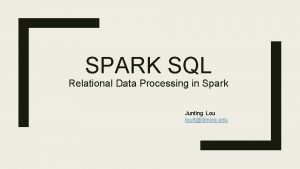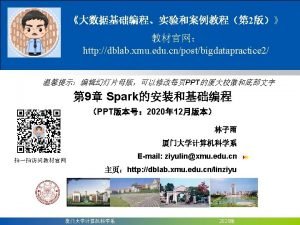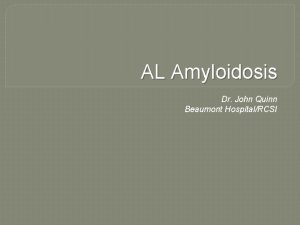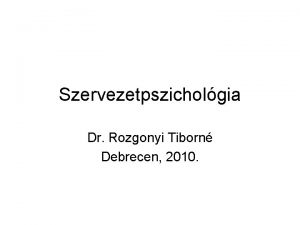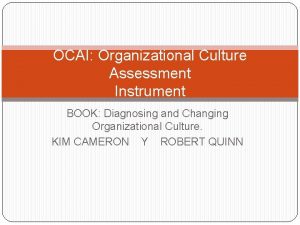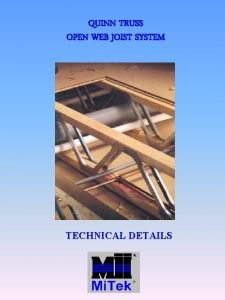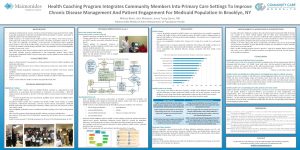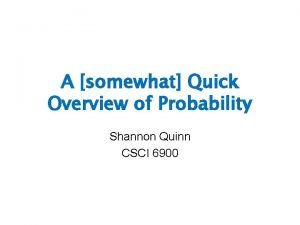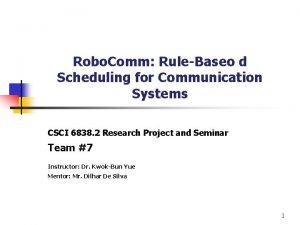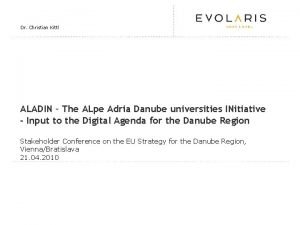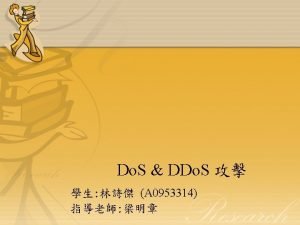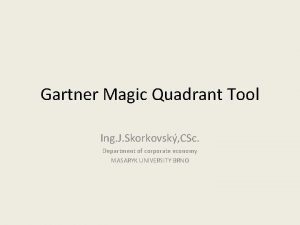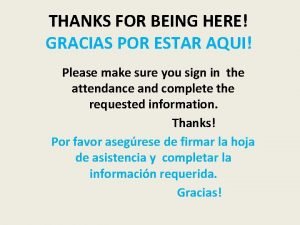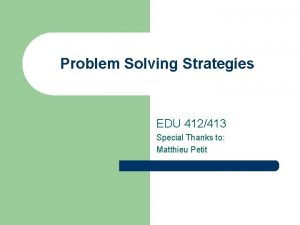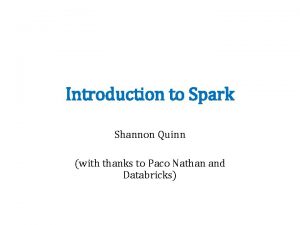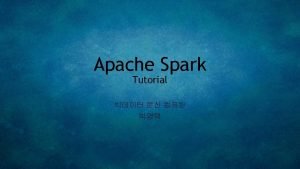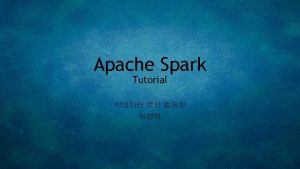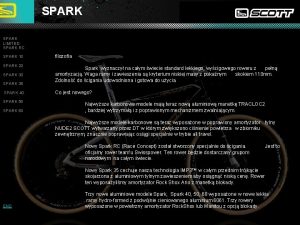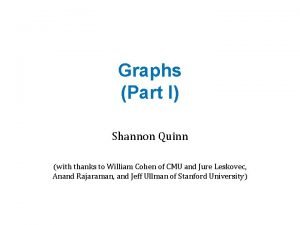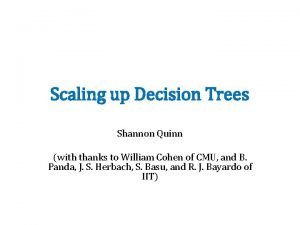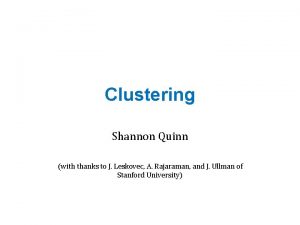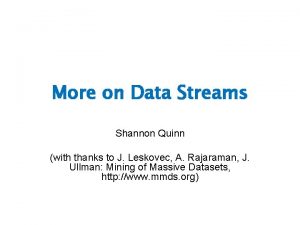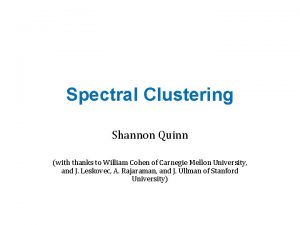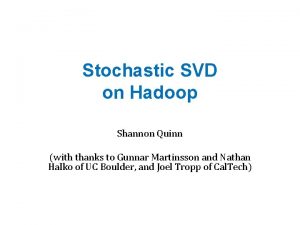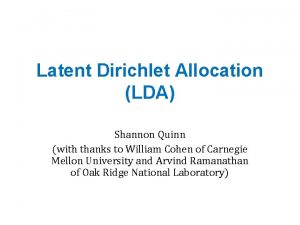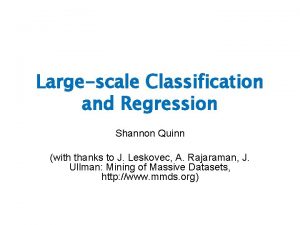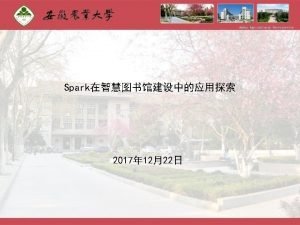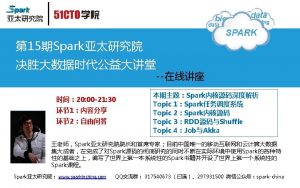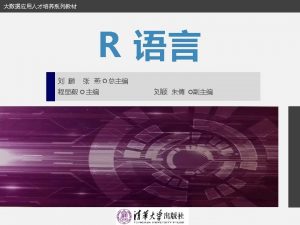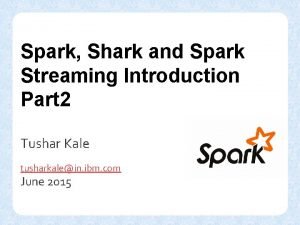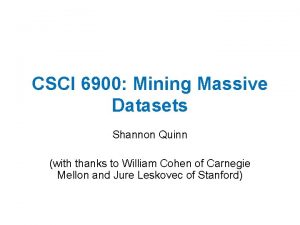Introduction to Spark Shannon Quinn with thanks to




















































- Slides: 52

Introduction to Spark Shannon Quinn (with thanks to Paco Nathan and Databricks)

Quick Demo

Quick Demo

API Hooks • Scala / Java – All Java libraries – *. jar – http: //www. scalalang. org • Python – Anaconda: https: //store. continuu m. io/cshop/anaconda/ • …R? – If you really want to – http: //spark. apache. or g/docs/latest/sparkr. ht ml

Introduction

Spark Structure • Start Spark on a cluster • Submit code to be run on it










Another Perspective

Step by step

Step by step

Step by step

Example: Word. Count

Example: Word. Count

Limitations of Map. Reduce • Performance bottlenecks—not all jobs can be cast as batch processes – Graphs? • Programming in Hadoop is hard – Boilerplate boilerplate everywhere

Initial Workaround: Specialization

Along Came Spark • Spark’s goal was to generalize Map. Reduce to support new applications within the same engine • Two additions: – Fast data sharing – General DAGs (directed acyclic graphs) • Best of both worlds: easy to program & more efficient engine in general

Codebase Size

More on Spark • More general – Supports map/reduce paradigm – Supports vertex-based paradigm – Supports streaming algorithms – General compute engine (DAG) • More API hooks – Scala, Java, Python, R • More interfaces – Batch (Hadoop), real-time (Storm), and interactive (? ? ? )

Interactive Shells • Spark creates a Spark. Context object (cluster information) • For either shell: sc • External programs use a static constructor to instantiate the context

Interactive Shells • spark-shell --master

Interactive Shells • Master connects to the cluster manager, which allocates resources across applications • Acquires executors on cluster nodes: worker processes to run computations and store data • Sends app code to executors • Sends tasks for executors to run

Resilient Distributed Datasets (RDDs) • Resilient Distributed Datasets (RDDs) are primary data abstraction in Spark – Fault-tolerant – Can be operated on in parallel 1. Parallelized Collections 2. Hadoop datasets • Two types of RDD operations 1. Transformations (lazy) 2. Actions (immediate)

Resilient Distributed Datasets (RDDs)

Resilient Distributed Datasets (RDDs) • Can create RDDs from any file stored in HDFS – Local filesystem – Amazon S 3 – HBase • Text files, Sequence. Files, or any other Hadoop Input. Format • Any directory or glob – /data/201414*

Resilient Distributed Datasets (RDDs) • Transformations – Create a new RDD from an existing one – Lazily evaluated: results are not immediately computed • Pipeline of subsequent transformations can be optimized • Lost data partitions can be recovered

Resilient Distributed Datasets (RDDs)

Resilient Distributed Datasets (RDDs)

Resilient Distributed Datasets (RDDs)

Resilient Distributed Datasets (RDDs)

Closures in Java

Resilient Distributed Datasets (RDDs) • Actions – Create a new RDD from an existing one – Eagerly evaluated: results are immediately computed • Applies previous transformations • (cache results? )

Resilient Distributed Datasets (RDDs)

Resilient Distributed Datasets (RDDs)

Resilient Distributed Datasets (RDDs)

Resilient Distributed Datasets (RDDs) • Spark can persist / cache an RDD in memory across operations • Each slice is persisted in memory and reused in subsequent actions involving that RDD • Cache provides fault-tolerance: if partition is lost, it will be recomputed using transformations that created it

Resilient Distributed Datasets (RDDs)

Resilient Distributed Datasets (RDDs)

Broadcast Variables • Spark’s version of Hadoop’s Distributed. Cache • Read-only variable cached on each node • Spark [internally] distributed broadcast variables in such a way to minimize communication cost

Broadcast Variables

Accumulators • Spark’s version of Hadoop’s Counter • Variables that can only be added through an associative operation • Native support of numeric accumulator types and standard mutable collections – Users can extend to new types • Only driver program can read accumulator value

Accumulators

Key/Value Pairs

Resources • Original slide deck: http: //cdn. liber 118. com/workshop/itas_work shop. pdf • Code samples: – https: //gist. github. com/ceteri/f 2 c 3486062 c 9610 eac 1 d – https: //gist. github. com/ceteri/8 ae 5 b 9509 a 08 c 08 a 1132 – https: //gist. github. com/ceteri/11381941

Assignment 3! • Clustering on Spark • Data: more text documents! – NIPS abstracts (~1. 9 M) – NY Times articles (~100 M) – Pub. Med abstracts (~730 M) • Spark APIs • Compare clustering methods
 Spark sql: relational data processing in spark
Spark sql: relational data processing in spark Introduction to apache spark
Introduction to apache spark Edel quinn
Edel quinn Ucf capstone cheating
Ucf capstone cheating Hornby cdu
Hornby cdu Marc quinn, self, 1991
Marc quinn, self, 1991 Oh mary conceived without sin
Oh mary conceived without sin Dr john quinn beaumont
Dr john quinn beaumont Ashlynn quinn
Ashlynn quinn Quinn modell
Quinn modell Instrumento ocai
Instrumento ocai Duane quinn
Duane quinn Feargal quinn
Feargal quinn Self – marc quinn, 1991
Self – marc quinn, 1991 Jim quinn net worth
Jim quinn net worth Penny quinn
Penny quinn Strongback bridging
Strongback bridging Paulyn marrinan quinn
Paulyn marrinan quinn Unos region 5
Unos region 5 Jenny tsang-quinn
Jenny tsang-quinn Quinn prob
Quinn prob Alleluia alleluia give thanks to the risen lord lyrics
Alleluia alleluia give thanks to the risen lord lyrics Thanks for the victory
Thanks for the victory Thank you for listening slide
Thank you for listening slide Thanks for listen
Thanks for listen Gustatory system
Gustatory system Thanks for listening
Thanks for listening How to reply thanks
How to reply thanks Thanks any question
Thanks any question Give thanks to the lord our god and king
Give thanks to the lord our god and king Christian kittl
Christian kittl Thanks to god for my redeemer
Thanks to god for my redeemer Oh give thanks to the lord for he is good
Oh give thanks to the lord for he is good Thanks for your attencion
Thanks for your attencion Ten thousand thanks to jesus
Ten thousand thanks to jesus Thanks for your listening!
Thanks for your listening! Thanks for teamwork
Thanks for teamwork Kwakiutl prayer of thanks
Kwakiutl prayer of thanks Thanks a lot for your letter
Thanks a lot for your letter Vote of thanks format
Vote of thanks format Is the gulf stream warm or cold
Is the gulf stream warm or cold From woodlands to plains
From woodlands to plains Dear ben thank you for your letter
Dear ben thank you for your letter Challengers leaders niche players visionaries
Challengers leaders niche players visionaries Give thanks michael w smith
Give thanks michael w smith First of all thanks to allah
First of all thanks to allah Farabi is flora's best friend passage model question
Farabi is flora's best friend passage model question Welcome thanks for joining us
Welcome thanks for joining us Thanks for bringing us together
Thanks for bringing us together Thanks for being here
Thanks for being here Thank you to all the sponsors
Thank you to all the sponsors Thanks for your kind notice
Thanks for your kind notice Thanks for solving the problem
Thanks for solving the problem
